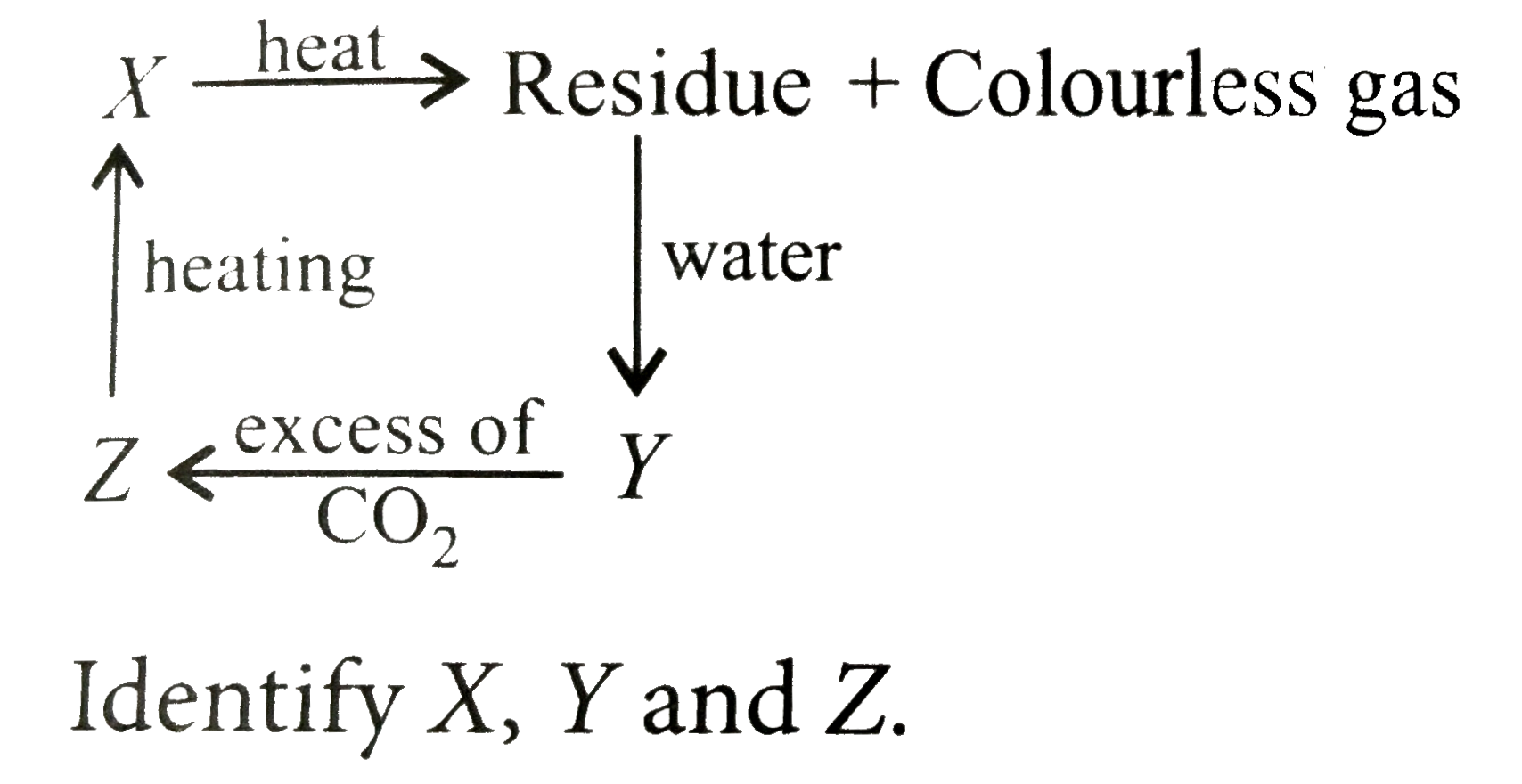A metal M reacts with sodium hydroxide to give a white precipitate X which is soluble in excess of NaOH to give Y. Compound X is soluble in HCI to form a compound Z. Identify M.X,Y and Z
M , X , Y, Z
Si,SiO2,Na2siO3,SiCI4
AI,AiI(OH)3,NaMgO3,AICI3
Mg,Mg(Oh)3,NaMgO3,MgCI2
Ca,Ca(OH)2,Na2CO3,NaHCO3
The correct Answer is:B
To solve the problem, we need to identify the metal (M), the white precipitate (X), the compound formed in excess NaOH (Y), and the compound formed when X is dissolved in HCl (Z).
1. Identify the Metal (M):
The metal M must be amphoteric, meaning it can react with both acids and bases. A common metal that fits this description is aluminum (Al).
2. Reaction with Sodium Hydroxide (NaOH):
When aluminum reacts with sodium hydroxide, it forms aluminum hydroxide, which is a white precipitate. The reaction can be represented as:
2Al+2NaOH+6H2O→2Al(OH)3(s)+2Na+
Here, the white precipitate (X) is aluminum hydroxide, Al(OH)₃.
3. Solubility in Excess NaOH:
Aluminum hydroxide (X) is soluble in excess sodium hydroxide, forming sodium aluminate (Y). The reaction is:
Al(OH)3(s)+OH−→NaAlO2(aq)+2H2O
Thus, Y is sodium aluminate, NaAlO₂.
4. Solubility in HCl:
When aluminum hydroxide (X) is dissolved in hydrochloric acid (HCl), it forms aluminum chloride (Z). The reaction can be represented as:
Al(OH)3(s)+3HCl→AlCl3(aq)+3H2O
Therefore, Z is aluminum chloride, AlCl₃.
Summary of Identifications:
- M: Aluminum (Al)
- X: Aluminum hydroxide (Al(OH)₃)
- Y: Sodium aluminate (NaAlO₂)
- Z: Aluminum chloride (AlCl₃)
The metal M must be amphoteric, meaning it can react with both acids and bases. A common metal that fits this description is aluminum (Al).
When aluminum reacts with sodium hydroxide, it forms aluminum hydroxide, which is a white precipitate. The reaction can be represented as:
2Al+2NaOH+6H2O→2Al(OH)3(s)+2Na+
Here, the white precipitate (X) is aluminum hydroxide, Al(OH)₃.
Aluminum hydroxide (X) is soluble in excess sodium hydroxide, forming sodium aluminate (Y). The reaction is:
Al(OH)3(s)+OH−→NaAlO2(aq)+2H2O
Thus, Y is sodium aluminate, NaAlO₂.
When aluminum hydroxide (X) is dissolved in hydrochloric acid (HCl), it forms aluminum chloride (Z). The reaction can be represented as:
Al(OH)3(s)+3HCl→AlCl3(aq)+3H2O
Therefore, Z is aluminum chloride, AlCl₃.
- M: Aluminum (Al)
- X: Aluminum hydroxide (Al(OH)₃)
- Y: Sodium aluminate (NaAlO₂)
- Z: Aluminum chloride (AlCl₃)
Topper's Solved these Questions
- THE P-BLOCK ELEMENTSBOOK - NCERT FINGERTPS ENGLISHCHAPTER - THE P-BLOCK ELEMENTSEXERCISE - HIGHER ORDER THINKING SKILLS
9 Videos
- THE P-BLOCK ELEMENTSBOOK - NCERT FINGERTPS ENGLISHCHAPTER - THE P-BLOCK ELEMENTSEXERCISE - EXEMPLAR PROBLEMS
15 Videos
- STRUCTURE OF ATOM BOOK - NCERT FINGERTPS ENGLISHCHAPTER - STRUCTURE OF ATOM EXERCISE - Assertion And Reason
15 Videos
- THE S-BLOCK ELEMENTSBOOK - NCERT FINGERTPS ENGLISHCHAPTER - THE S-BLOCK ELEMENTSEXERCISE - Assertion And Reason
15 Videos
Similar Questions
Knowledge Check
The order of stability of compounds X, Y and Z :
 AX>Y>ZBY>Z>XCZ>X>YDX>Z>Y
AX>Y>ZBY>Z>XCZ>X>YDX>Z>Y
When metal X is treated with sodium hydroxide, a white precipitate (A) is obtained, which is soluble in excess of NaOH to give soluble complex (B). Compound (A) is soluble in dilute HCl to form compound (C). The compound (A) when heated strongly gives (D), which is used to extract metal. Identify (X), (A), (B), (C) and (D). Write suitable equations to support their identities.
View SolutionWhen metal ‘M’ is treated with NaOH, a white gelatinous precipitate ‘X’ is obtained, which is soluble in excess of NaOH. Compound ‘X’ when heated strongly gives an oxide which is used in chromatography as an adsorbent. The metal ‘M’ is
View SolutionThe solution of a chemical compound X reacts with AgNO3 solution to form a white precipitate of Y which dissolves in NH4OH to give Z. When Z is treated with dil HNO3 ,Y reappears .The chemical compound X can be
View SolutionX on treatment with sodium hydroxide followed by the addition of silver nitrate give white precipitate at room temperature which are soluble in NH4OH. X can be :
View SolutionA metal 'X' normally used for making calorimeters is heated in abundant supply of air until a black coloured residue ' Y' is obtained. This Y reacts with sulphuric acid to form blue coloured salt 'Z'. When to this solution little of ammonium hydroxide was added, pale blue precipitates of 'A' are obtained. This 'A' dissolves in excess of ammonium hydroxide to form a deep blue solution B. Identify the metal X and write the equations for the formation of various compounds i.e., Y, Z, A and B.
View SolutionA metal 'X' used to make calorimeters reacts with concentrated nitric acid to form a soluble salt Y. When few drops of ammonium hydroxide are added pale blue precipitates 'Z' are obtained. These precipitates dissolve in excess of ammonium hydroxide to form deep blue solution 'A'. Identify the metal X and give all the chemical equations.
View SolutionWhen sulphur is boiled is boiled with Na2SO3, a compound (X) is produced, (X) with excess of AgNO3 solution gives a compound (Y) which is soluble in water and produces a black coloured sulphide (Z). Identify compounds (X),(Y) and (Z).
View Solution


